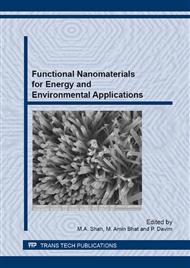[1]
Abouzied M.and Reddy M.1986. Direct fermentation of Potato Starch to ethanolby cocultures of Aspergillus niger and Saccharmyces cerevisiae. Appl. Environ. Microbiol. 52:1055-1059.
DOI: 10.1128/aem.52.5.1055-1059.1986
Google Scholar
[2]
Aiyer P.V. D. 2004. Effect of C:N ratio on alpha amlase production by Bacillus licheniformis spt 27. African Journal of Biotechnology. 3:519-522
DOI: 10.5897/ajb2004.000-2103
Google Scholar
[3]
Bergman F.W., Abe J, Hizukurji S. 1988. Selection of microorganism which produce raw starch degrading amylase. Appl. Microbiol. Biotechno. 27:443-446.
DOI: 10.1007/bf00451610
Google Scholar
[4]
Burbidge E. and Collier B. 1968. Production of bacterial amylases. Process Biochem. 3:53-56.
Google Scholar
[5]
Dobreva Elena. 1994. Thermostabile -amylase production by immobilized Bacillus licheniformis cells in agar gel and on acrylonitrile/acrylamide membranes Appl. Мicrobiol. Biotechnol., 41: 517-523.
DOI: 10.1007/bf00178482
Google Scholar
[6]
Ekunsumi Toye 2002. Laboratory Production and assay of amylase by bacteria and fungi.1:1-8
Google Scholar
[7]
Gangadharan D., Sivaramakrishnan S., Madhavan K. N. and Pandey A. 2006 Alpha- Amylase production by B. amyloliquefaciens. Food Techno Biotechnol 44: 269-274.
Google Scholar
[8]
Guchte Van de, Kodde M.J., Vander Vossen J.M.B.M., Kok J. and Venema G. 1990. Heterologous gene expression in Lactococcus lactis sub sp. lactis: synthesis, secretion and processing of the Bacillus subtilis neutral protease. Appl. Environ, Microbiol. 56:2606-2611.
DOI: 10.1128/aem.56.9.2606-2611.1990
Google Scholar
[9]
Hols P.T., Ferain D., Garmyn N., Bernard, A. and Delcour J. 1994. Use of homologous expression. Secretion signals and vector – free stable chromosomal integration 'n' engineering of Lactobacillus plantarum for Alpaamylase and levanase expression. Appl.Environ-Microbiol. 60:1401- 1413.
DOI: 10.1128/aem.60.5.1401-1413.1994
Google Scholar
[10]
Krishnan T. and Chandra A. K. 1983. Purification and Characterization of -Amylase from Bacillus licheniformis CUMC 305. Appl Environ Microbiol. 46(2): 430-437
DOI: 10.1128/aem.46.2.430-437.1983
Google Scholar
[11]
Lealem F.and Gashe B.A. 1994. Amylase Production by gram Positive bacteria isolated from fermenting tef (Eragrostis tef) Journal of Applied Microbiology. 86:557-560
DOI: 10.1111/j.1365-2672.1994.tb03084.x
Google Scholar
[12]
Mamo G., Gashe B.A. and Gessesse A. 2001. A highly thermostable amylase from a newly isolated thermophilic Bacillus sp. WN 11. Journal of Applied Microbiology. 86:557-560.
DOI: 10.1046/j.1365-2672.1999.00685.x
Google Scholar
[13]
Medda S. and Chandra A. K. 2008. New Strains of Bacillus licheniformis and Bacillus coagulans producing Thermostable α-Amylase Active at Alkaline pH.Journal of Applied Microbiology. 48 (1): 47 – 58
DOI: 10.1111/j.1365-2672.1980.tb05205.x
Google Scholar
[14]
Nigam. P. and Singh D. 1995. Enzyme and microbial system involved in starch processing. Enzyme Microbe Techno. 17:770-778.
DOI: 10.1016/0141-0229(94)00003-a
Google Scholar
[15]
Rao D. M., Purnima A. , Ramesh D.V. and Ayyanna C. 2002. Purification of α- amylase from Bacillus licheniformis by chromatofocusing and gel filtration chromatography. World Journal of Microbiology and Biotechnology. 18: 959- 993.
Google Scholar
[16]
Rothstein D. M., Devlin P. E., and Cate R. L. 1986. Expression of alphaamylase in Bacillus licheniformis. J. Bacteriol. 168(2): 839–842.
DOI: 10.1128/jb.168.2.839-842.1986
Google Scholar
[17]
Saito N.K. Yamamoto.1975.Regulatory factors affecting Alpha-amylase production in Bacillus licheniformis. Journal of Bacteriology. 121:848-856.
DOI: 10.1128/jb.121.3.848-856.1975
Google Scholar
[18]
Thaddeus C., Ezeji and Hubert Bahl. 2006. Purification, characterization and synergistic action of phytate-resistant α-amylase and α-glucosidase from Geobacillus thermodenitrificans HRO10. Journal of Biotechnology. 125: 27-38
DOI: 10.1016/j.jbiotec.2006.02.006
Google Scholar
[19]
Yamane K, Hirata Y., Furusato J., Yamazaki H. and Nakayama A. 1984. Changes in the properties and molecular weight of Bacillus subtilis M-type and N-type Alpha-amylases resulting from a spontaneous deletion. J. Biochem. 96:1849-1858.
DOI: 10.1093/oxfordjournals.jbchem.a135019
Google Scholar


